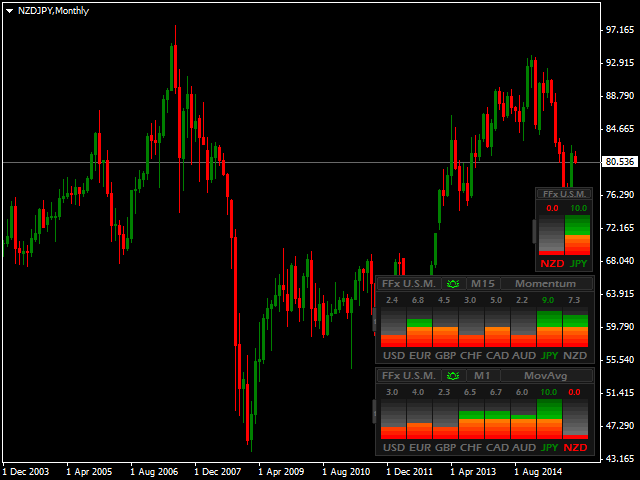FFx Universal Strength Meter PRO doesn’t just measure strength. In addition to calculating the price, it has 19 built-in modes 9 timeframes. With the FFx USM indicator, you can determine any period for any combination of timeframes. For example, you can set the panel for the last 10 candles for M15-H1-H4… The settings are very flexible!
The indicator is easy to use… It provides information on the strength and weakness of currencies, allowing you to find the most suitable pairs for trading.
Example: If EUR is strong and USD is weak, it’s time to look for an opportunity to make a purchase on EURUSD.
Alerts are also provided when certain currency pairs reach strong or weak levels.
- Strength Mode: Strength calculation mode… (Price, Moving Average, MACD, Stochastic, RSI, WPR, Momentum, CCI, ADX, PSAR, DeMarker, AC, AO, Bulls, Bears, Ichimoku, Force Index, OsMA, RVI). Of course, each indicator has its own standard input parameters, which you can also change. You can switch between different modes right on the chart!
- Strength Period: the number of candles to calculate. You can set any value starting from 1…
- Strength Timeframes: When calculating strength, several timeframes can be combined (1=M1 .. 5=M5 .. 15=M15 .. 30=M30 .. 60=H1 .. 240=H4 .. 1440=D1 .. 10080=W1 .. 43200=MN1).
- Symbol prefix/suffix: If your broker’s symbols look like xxx EURUSD yyy, just add xxx as a prefix and yyy as a suffix.
- Horizontal/Vertical Shift: Horizontal/vertical shift of the panel on the chart.
- Strong/Weak Levels: strong/weak levels; from 1 to 10, when a level is reached, an alert (pop-up window/audio/email/push notification) is triggered, while the currency changes color for greater clarity. Alerts are enabled/disabled directly on the chart using the bell icon (at least one type of alert must be activated in the parameters).
- All other settings are parameters of standard indicators that match those provided by the MT4 platform.
[spoiler title=”Read More…”]
The panel has a compact mode (only two currencies are displayed for the current chart). Just click on the left edge of the panel, as shown in the video.
[/spoiler]





